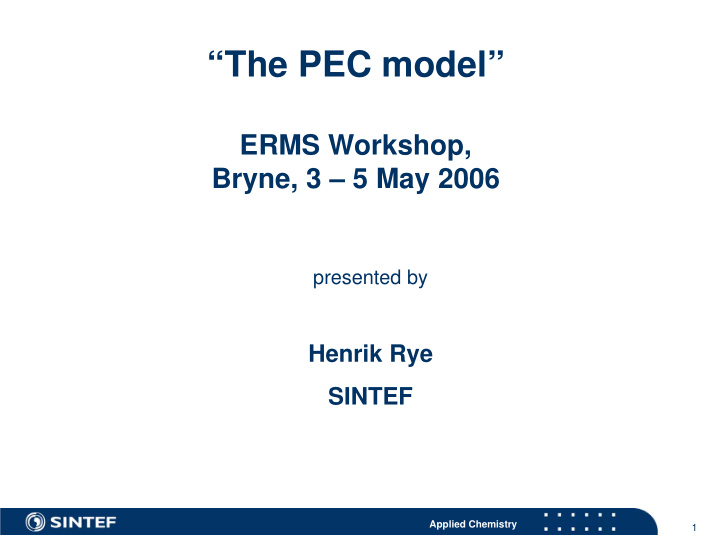



“The PEC model” ERMS Workshop, Bryne, 3 – 5 May 2006 presented by Henrik Rye SINTEF Applied Chemistry 1
Model structure: Model Discharge Environmental parameters data data /databases ERMS model Risk Concentration Pie charts and calculations fields time plots Applied Chemistry 2
Near field plume, dissolved chemicals and settling of particles: Near field DREAM module ParTrack module Sediment module Applied Chemistry 3
Risk areas/volumes are calculated for: � Water volume where PEC/PNEC > 1 for � Chemical stress (toxicity) � Particle stress in the water column (barite) � Sediment surface area where PEC/PNEC > 1 for � Chemical stress (toxicity) � Burial � Change in grain size � Oxygen depletion Applied Chemistry 4
Impact on water column: Impact: Discharge compound: Chemicals with Pow < 1000 Chemical stress Chemicals with Pow > 1000 Heavy metals in barite Particle stress Particles in mud Cuttings Water column Sediment Applied Chemistry 5
Impact on sediment: Discharge compound: Impact: Water column Sediment Chemicals with Pow < 1000 Chemical stress Chemicals with Pow > 1000 Heavy metals in barite Oxygen depletion Particles in mud Cuttings Grain size change and burial Applied Chemistry 6
Dissolved compounds in the water column: � Equation 2. Calculation of local PEC seawater for the marine environment (ERMS approach) � PEC seawater = C discharge * exp (- kt) /DILUTION � PEC seawater = local concentration in seawater during emission episode [mg*l -1 ] � C discharge = concentration of the substance in the discharge [mg*l -1 ] � k = biodegradation factor (days -1 ) � t = time (days) � DILUTION = dilution factor [-] Applied Chemistry 7
Dissolved metals from barite in the water column: � Equation 4. Calculation of local PEC seawater for dissolved metals from barite in the marine environment (ERMS approach) � PEC seawater = (C discharge /DILUTION) * (FRACTION /Kp metal ) � PEC seawater = local concentration in seawater of dissolved metal [mg*l -1 ] � C discharge = concentration of barite particles in the discharge [mg*l -1 ] � DILUTION = dilution factor for dilution of the discharge in recipient water (-) � FRACTION = fraction of the metal in barite (kg metal/kg barite) � Kp metal = partition coefficient between the metal in barite and dissolved metal Applied Chemistry 8
Partition coefficient for metals in the water column: � Equation 5. Calculation of Kp metal (TGD approach) � Kp metal = C sol /C aqu � Csol = Total available concentration in the solid phase [mg*kg-1] Caqu = Available concentration in the aqueous phase [mg*kg-1] Applied Chemistry 9
PEC for sediment (ERMS approach): � Equation 9. Calculation of local PEC sediment for the marine environment (ERMS approach) � PEC sediment = [1000 / RHO susp ] * PEC discharge /DEPOSITION � PEC discharge = concentration in discharge pipe [mg*l-1] � DEPOSITION = deposition factor calculated by the model (-) � RHO susp = bulk density of suspended matter in sediment [kg*m-3] � PEC sediment = predicted environmental concentration in sediment [mg*kg-1] Applied Chemistry 10
PEC for organic chemicals in sediment: � Equation 10. Calculation of local PEC sediment for organic chemicals in sediment (ERMS approach): � PEC sediment = PEC (t =0) sediment * exp (- kt) /BIOTURB � PEC sediment = concentration of chemical in the sediment [mg*kg -1 ] � PEC (t =0) sediment = same as above for the initial time step t = 0. � k = biodegradation factor for chemical in the sediment [days -1 ] � t = time [days] � BIOTURB = dilution factor in the sediment due to effects from bioturbation [-] Applied Chemistry 11
Partition of organic chemicals in sediment: � Equation 11. Calculation of local pore water concentration PEC porewater for organic chemicals (TGD approach): � PEC porewater = [RHO susp /1000] * PEC sediment * Kp susp-water � PEC porewater = concentration of chemical in the pore water [mg*l -1 ] � PEC sediment = concentration of chemical in the sediment [mg*kg -1 ] � RHO susp- water = bulk density of suspended matter [kg/m -3 ] � Kp susp water = suspended matter-water partitioning coefficient [m 3 *m -3 ] Applied Chemistry 12
Partition coefficient for organic matter in sediment: � Equation 12. Calculation of Kp susp-water of non-ionic organic substances in sediment (TGD approach) � Kp susp-water = F oc * K oc � K oc = partition coefficient organic carbon-water [l*kg-1] F oc = weight fraction of organic carbon in compartment [kg*kg-1] Applied Chemistry 13
Barite heavy metals conc. in sediment: � Equation 13. Calculation of local PEC metal for barite metals in sediment (ERMS approach): � PEC metal = PEC (t =0) sediment * FRACTION /BIOTURB � PEC metal = concentration of barite metal in the sediment [mg*kg -1 ] � PEC (t =0) sediment = concentration of deposited barite in the sediment at t = 0 [mg*kg -1 ] � FRACTION = content of the metal in barite [kg metal * kg -1 barite] � BIOTURB = dilution factor in the sediment due to effects from bioturbation [-] Applied Chemistry 14
Pore water dissolved heavy metal concentration in sediment: � Equation 14. Calculation of local pore water concentration PEC porewater for barite metals (ERMS approach): � PEC porewater = [RHO susp /1000] * PEC metal * Kp metal-water � PEC porewater = concentration of dissolved metal in the pore water [mg*l -1 ] � PEC metal = concentration of metal in the sediment [mg*kg -1 ] � RHO susp = bulk density of suspended matter [kg/m -3 ] � Kp metal-water = barite metal-water partitioning coefficient [m 3 *m -3 ] Applied Chemistry 15
Recommend
More recommend